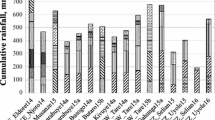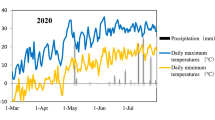Abstract
Similar to other regions of Asia, irrigated wheat (Triticum aestivum L.) yield increases in Punjab, India, have slowed in recent years. Future yield increases may occur in smaller increments through fine-tuning of crop management mainly by accounting for the large spatial and temporal variation in soil characteristics. On-farm experiments were conducted from 2002–03 to 2004–05 on 56 irrigated wheat farms (hereafter referred to as ‘sites’) in six key irrigated rice (Oryza sativa L.)-wheat regions of Punjab to evaluate an approach for site-specific nutrient management (SSNM). Site-specific N–P–K applications were calculated by accounting for the indigenous nutrient supply, yield targets, and nutrient demand as a function of the interactions between N, P, and K. The performance of SSNM was tested for two wheat crops. Compared with the current farmers’ fertilizer practice (FFP), average grain yield increased from 4.2 to 4.8 Mg ha−1, while plant N, P, and K accumulations increased by 12–20% with SSNM. The gross return above fertilizer cost (GRF) was about 13% greater with SSNM than with FFP. Improved timing and/or splitting of fertilizer N increased N recovery efficiency from 0.17 kg kg−1 in FFP plots to 0.27 kg kg−1 in SSNM plots. The agronomic N use efficiency was 63% greater with SSNM than with FFP. As defined in our study, SSNM has potential for improving yields and nutrient use efficiency in irrigated wheat. Future research must build on the present approach to develop a more practical way for achieving similar benefits across large areas without site-specific modeling and with minimum crop monitoring.



Similar content being viewed by others
References
Aggarwal PK, Kropff MJ, Cassman KG, ten Berge HFM (1997) Simulating genetic strategies for increased yield potential in irrigated, tropical environments. Field Crops Res 51:5–18
Aggarwal PK, Bandyopadhyay SK, Pathak H, Kalra N, Chander S, Kumar SS (2000) Analyses of yield trends of the rice-wheat system in north-western India. Outlook Agric 29:259–268
Anonymous (2005) India 2005 – a reference annual. Publ Div, Ministry of Information and Broadcasting, Gov of India, 654 pp
Bijay-Singh, Yadvinder-Singh (2003) Environmental implications of nutrient use and crop management in rice-wheat cropping system. In: Yadvinder-Singh et al (eds) Nutrient management for sustainable rice-wheat cropping system. Natl Agric Tech Project, Indian Counc Agric Res, New Delhi, India, and Punjab Agric Univ, Ludhiana, Punjab, India, pp 398–412
Bijay-Singh, Yadvinder-Singh, Ladha JK, Bronson KF, Balasubramanian V, Jagdeep-Singh, Khind CS (2002) Chlorophyll meter- and leaf color chart-based nitrogen management for rice and wheat in northwestern India. Agron J 94:821–829
Bijay-Singh, Yadvinder-Singh, Nayyar VK (2003a) Rice-wheat cropping systems in the Indo-gangetic plains of India: characteristic features, fertilizer use and nutrient management issues. In: Yadvinder-Singh et al (eds) Nutrient management for sustainable rice-wheat cropping system. Natl Agric Tech Project, Indian Counc Agric Res, New Delhi, India, and Punjab Agric Univ, Ludhiana, Punjab, India, pp 1–17
Bijay-Singh, Yadvinder-Singh, Vashishta M (2003b) Potassium nutrition of rice-wheat cropping system in the Indo-gangetic plains of India: characteristic features, fertilizer use and nutrient management issues. In: Yadvinder-Singh et al (eds) Nutrient management for sustainable rice-wheat cropping system. Natl Agric Tech Project, Indian Counc Agric Res, New Delhi, India, and Punjab Agric Univ, Ludhiana, Punjab, India, pp 161–186
Bremner JM (1996) Nitrogen-total. In: Sparks DL et al (eds) Methods of soil analysis, part 3– chemical methods. Soil Sci Soc Am, Madison, Wisconsin, pp 1085–1121
Cassman KG, Harwood RR (1995) The nature of agricultural systems – food security and environmental balance. Food Policy 20:439–454
Cassman KG, Peng S, Olk DC, Ladha JK, Reichardt W, Dobermann A, Singh U (1998) Opportunities for increased nitrogen use efficiency from improved resource management in irrigated rice systems. Field Crops Res 56:7–38
Dobermann A, Cassman KG (2002) Plant nutrient management for enhanced productivity in intensive grain production systems of the United States and Asia. Plant Soil 247:153–175
Dobermann A, White PF (1999) Strategies for nutrient management in irrigated and rainfed lowland rice systems. Nutr Cycl Agroecosyst 53:1–18
Dobermann A, Witt C, Dawe D (eds) (2004) Increasing productivity of intensive rice systems through site-specific nutrient management. Sci Publ Inc, Enfield, New Hampshire, USA, and IRRI, Los Baños, Philippines, pp 101–286
Duxbury JM (2001) Long-term yield trends in the rice-wheat cropping system: results from experiments in northwest India. J Crop Prod 3:27–52
FAO (1994a) Land degradation in south Asia: its severity, causes and effects upon people. World Soil Resources Report 78. FAO, Rome, Italy
FAO (1994b) Sustainability of rice-wheat production systems in Asia. Proceedings of the expert consultation on the sustainability of the rice-wheat production systems on different agro-ecological settings in Asia, 1993. FAO Regional Office for Asia and the Pacific, Bangkok, Thailand
Helmke PA, Sparks DL (1996) Lithium, sodium, potassium, rubidium, and cesium. In: Sparks DL et al (eds) Methods of soil analysis, part 3 – chemical methods. Soil Sci Soc Am, Madison, Wisconsin, pp 551–574
IRRI (2006) Site-specific nutrient management. Available at http://www.irri.org/irrc/ssnm/SSNM/currentversionSSNM.asp. verified 31 Oct. 2007. IRRI, Metro Manila, the Philippines
Janssen BH, Guiking FCT, van der Eijk D, Smaling EMA, Wolf J, Reuler H (1990) A system for quantitative evaluation of the fertility of tropical soils (QUEFTS). Geoderma 46:299–318
Kuo S (1996) Phosphorus. In: Sparks DL et al (eds) Methods of soil analysis, part 3 – chemical methods. Soil Sci Soc Am, Madison, Wisconsin, pp 869–919
Ladha JK, Fischer KS, Hossain M, Hobbs PR, Hardy B (eds) (2000) Improving the productivity and sustainability of rice-wheat systems of the Indo-Gangetic Plains: a synthesis of NARS-IRRI partnership research. p. 31. IRRI Disc Paper Ser No. 40, Makati City, Philippines
Ladha JK, Pathak H, Tirol-Padre A, Dawe D, Gupta RK (2003) Productivity trends in intensive rice-wheat cropping systems in Asia. In: Ladha JK et al (eds) Improving the productivity and sustainability of rice-wheat systems: issues and impacts. Am Soc Agron, Spl publ 65, Madison, Wisconsin, pp 45–76
Nelson DW, Sommers LE (1996) Total carbon, organic carbon and organic matter. In: Sparks DL et al (eds) Methods of soil analysis, part 3 – chemical methods. Soil Sci Soc Am, Madison, Wisconsin, pp 961–1010
Pathak H, Aggarwal PK, Roetter R, Kalra N, Bandyopadhaya SK, Prasad S, van Keulen H (2003a) Modelling the quantitative evaluation of soil nutrient supply, nutrient use efficiency, and fertilizer requirements of wheat in India. Nutr Cycl Agroecosyst 65:105–113
Pathak H, Ladha JK, Aggarwal PK, Peng S, Das S, Yadvinder-Singh, Bijay-Singh, Kamra SK, Mishra B, Sastri ASRAS, Aggarwal HP, Das DK, Gupta RK (2003b) Trends of climatic potential and on-farm yields of rice and wheat in the Indo-gangetic plains. Field Crops Res 80:223–234
Pathak H, Yadvinder-Singh, Bijay-Singh (2003c) Site-specific nutrient management for improving the productivity of rice-wheat cropping system. In: Yadvinder-Singh et al (eds) Nutrient management for sustainable rice-wheat cropping system. Natl Agric Tech Project, Indian Counc Agric Res, New Delhi, India, and Punjab Agric Univ, Ludhiana, Punjab, India, pp 79–98
Pierce FJ, Nowak P (1999) Aspects of precision agriculture. Adv Agron 67:1–85
SAS Institute (1988) SAS/STAT user’s guide, Release 6.03. SAS Inst, Cary, NC
Satterthwaite FE (1946) An approximate distribution of estimates of variance components. Biometrics Bull 2:110–114
Sheldrick BH, Wang C (1993) Particle size distribution. In: Carter MR (ed) Soil sampling and methods of analysis. Ed. ML Carter. Lewis publishers, Boca Raton, Florida, pp 499–511
Sidhu GS, Walia CS, Lal T, Rana KPC, Sehgal J (1995) Soils of Punjab: their kinds, distribution, characterization and interpretations for optimizing land use. Natl Bur Soil Survey and Land Use Planning, Indian Counc Agric Res, Nagpur, Madhya Pradesh, India
Sinha SK, Singh GB, Rai M (1998) In: Decline in crop productivity in Haryana and Punjab: Myth or Reality? Indian Counc Agric Res, New Delhi, India, 89 pp
Sta.Cruz PC, Simbahan GC, Hill JE, Dobermann A, Zeigler RS, Du PV, dela Pena FA, Samiayyan K, Suparyono, Tuat NV, Zhong Z (2001) Pest profiles at varying nutrient input levels. In: Peng S, Hardy B (eds) Rice research for food security and poverty alleviation. IRRI, Los Baños, the Philippines, pp 431–440
Sumner ME, Miller WP (1996) Cation exchange capacity and exchange coefficients. In: Sparks DL et al (eds) Methods of soil analysis. part 3—chemical methods. Soil Sci Soc Am, Madison, Wisconsin, pp 1201–1229
Timsina J, Connor DJ (2001) Productivity and management of rice-wheat cropping systems: issues and challenges. Field Crops Res 69:93–132
van Reeuwijk LP (1992) Procedures for soil analysis, 3rd edn. Intl Soil Reference and Inf Cent, Wageningen, The Netherlands
Walinga I, van der Lee JJ, Houba VJG, van Vark W, Novozamsky I (1995) Plant analysis manual. Kluwer Academic, Dordrecht
Witt C, Dobermann A, Abdulrachman S, Gines HC, Guanghuo W, Nagarajan R, Satawathananont S, Son TT, Tan PS, Tiem LV, Simbahan G, Olk DC (1999) Internal nutrient efficiencies in irrigated lowland rice of tropical and subtropical Asia. Field Crops Res 63:113–138
Wopereis MCS, Donovan C, Nebié B, Guindo D, N’Diaye MK (1999) Soil fertility management in irrigated rice systems in the Sahel and Savanna regions of West Africa. Part I—agronomic analysis. Field Crops Res 61:125–145
Yadvinder-Singh, Dobermann A, Bijay-Singh, Bronson KF, Khind CS (2000) Optimal phosphorus management strategies for wheat-rice cropping on a loamy sand. Soil Sci Soc Am J 64:1413–1422
Acknowledgments
We are grateful to the farmers in Punjab for their patience and excellent cooperation in conducting the on-farm experiments for this study.
Author information
Authors and Affiliations
Corresponding author
Rights and permissions
About this article
Cite this article
Khurana, H.S., Phillips, S.B., Bijay-Singh et al. Agronomic and economic evaluation of site-specific nutrient management for irrigated wheat in northwest India. Nutr Cycl Agroecosyst 82, 15–31 (2008). https://doi.org/10.1007/s10705-008-9166-2
Received:
Accepted:
Published:
Issue Date:
DOI: https://doi.org/10.1007/s10705-008-9166-2




